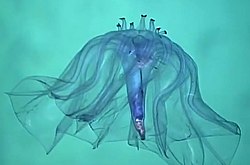| Pelagothuria | |
|---|---|
 | |
| Scientific classification | |
| Kingdom: | Animalia |
| Phylum: | Echinodermata |
| Class: | Holothuroidea |
| Order: | Elasipodida |
| Family: | Pelagothuriidae |
| Genus: | Pelagothuria Ludwig, 1893 |
| Species: | P. natatrix |
| Binomial name | |
| Pelagothuria natatrix Ludwig, 1893 | |
Pelagothuria is a genus of sea cucumber in the family Pelagothuriidae. It is monotypic, being represented by the single species Pelagothuria natatrix.



